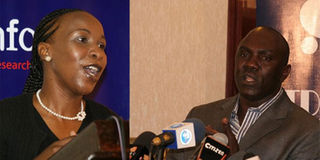Referendum results show opinion polling has come of age in Kenya

Infotrak Harris managing director Angela Ambitho (left) and Mr Caesar Handa, chief executive officer of Strategic PR. Photos/FILE
What you need to know:
How pollsters predicted result
Infotrak Harris. Last poll conducted between Juyly 28 and 30.
- Scenario one: If the undecided voters do not vote:
- Prediction: 67 per cent to vote Yes, 26 per cent to vote No, 7 per cent undecided
- Scenario two: If the undecided lot votes;
- Prediction: 70 per cent to vote yes, 30 percent to vote No.
- Margin of error: +/-2
Synovate: Last poll conducted between July 11 and 17
- Prediction: 58 percent to vote yes, 22 percent to vote No, 17 percent undecided, 3 percent to stay away from voting.
- Margin of error +/-1.6
The correct prediction of the outcome of the referendum on draft constitution shows that opinion polling in Kenya has come of age.
It has taken pollsters more than five years to gain acceptance, and be taken seriously, in the vibrant political field. As Kenyans celebrate the birth of new constitution, the role played by opinion polls in informing and shaping public perceptions cannot be wished away.
Even though fingers were pointed at the pollsters for giving a helping hand in the chaotic 2007 General Election that ended in violence, Kenyans quickly embraced opinion polling after the signing of the National Accord that gave birth to a coalition government.
When the Committee of Experts (CoE) first released the draft constitution, which proposed a hybrid system of government, opinion polls showed Kenyans were uncomfortable with power sharing, forcing the experts back to the drawing board.
This time round, all the polls done by respected companies predicted an endorsement for the draft constitution, save for two or three studies released by the ‘No’ camp whose objective was to act as propaganda tools. Strategic PR and Infotrak were the two companies that came closest in predicting the outcome of the poll.
The former in its last poll conducted between July 26 and 28, was one of the closest so far. It predicted 66 per cent would vote Yes, while 20 per cent would reject the document, with a margin of error of plus or minus 1.6. The organisation put the undecided group at 9 per cent and those who had refused to vote for various reasons at 5 per cent.
Infotrak Harris, on the other hand, in its study conducted between July 28, and 30, predicted 67 per cent of Kenyans would vote Yes, 26 per cent No and 7 per cent undecided. However, the study also said the undecided lot was more likely to be swayed by the Yes camp as the D-day nears, drastically changing the statistics.
In its final verdict, the pollster said if the undecided were to vote, the figure for Yes would increase to 70 per cent and 30 for No, all within a margin of error of plus or minus one. The official figures released by Interim Independent Electoral Commission on Sunday, showed that Yes camp had garnered 66.9 per cent (6,092,593) compared to 30.1 per cent (2,795,059 million).
Both companies expressed satisfaction with their prediction, saying opinion polls if conducted scientifically always reflected the perception on the ground. “We have been vindicated and our results were accurate, despite the criticisms we faced from politicians and other quarters,” said Strategic PR CEO Caesar Handa who spoke by telephone from Rwanda.
Both the Yes and the No camps, confirmed conducting individual polls. Joint leader of the ‘Yes’ secretariat Prof Peter Kagwanja confirmed the ‘Yes’ team conducted several opinion polls at the national and regional level. “Both ODM and PNU conducted joint opinion polls and individual polls in their strongholds to monitor public perception on the draft constitution,” said Prof Kagwanja.
He said the results of the polls influenced the way the team conducted campaigns, adding that it had to change tact in Central and Eastern Provinces after initial results showed lukewarm support for the document. “We turned to leaders at the grassroots after discovering we could not fully rely on politicians alone in the two provinces,” he added.
Justus Kigen, the communications officer of the ‘No’ secretariat, confirmed the team conducted three opinion polls to gauge public perception and for campaign strategy. All the polls conducted by Infotrak, Strategic PR and Synovate correctly predicted the voting patterns according to province, stating that Rift Valley and Eastern would be the ‘vote basket’ for the ‘No’ camp, with the rest of the provinces going green.
All the polls also correctly predicted that Nyanza and North Eastern provinces would have the highest percentage of ‘Yes’ supporters, and Rift Valley the least. However, the pollsters failed to capture the fact that ‘No’, and not ‘Yes’, would carry the day in Rift Valley Province, a proof of the difficulties in accurately capturing Kenya’s largest multi-ethnic province.
Mr Handa and Infotrak CEO, Angela Ambitho, said though the politicians dismissed their work in the day, but consulted their results in the night. “The ‘No’ camp dismissed us as sympathisers of the ‘Yes’ camp and supporting certain politicians but used our results to strategise its campaigns,” said Mr Handa.


